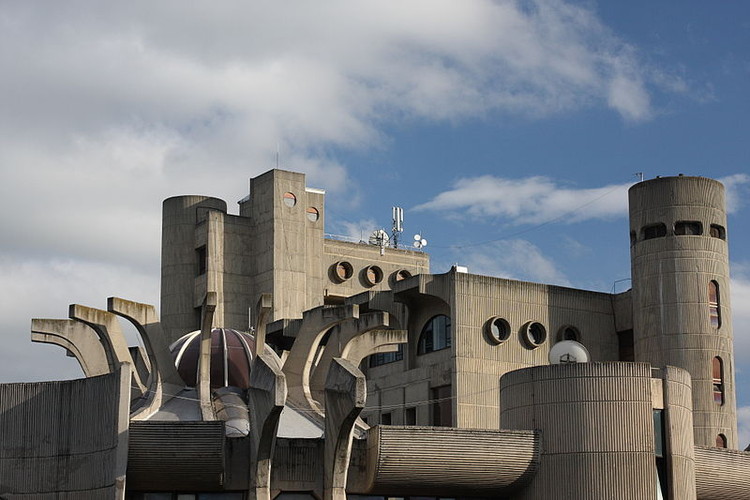
This article is part of "Eastern Bloc Architecture: 50 Buildings that Defined an Era", a collaborative series by The Calvert Journal and ArchDaily highlighting iconic architecture that had shaped the Eastern world. Every week both publications will be releasing a listing rounding up five Eastern Bloc projects of certain typology. Read on for your weekly dose: Eccentric Urban Buildings.
The Bank of Georgia’s Headquarters / George Tschachawa and Zurab Dschalagonia
Tbilisi, Georgia
1975

The Bank of Georgia’s headquarters, previously known as the Ministry of Highway Construction, is considered to be one of the most unique and irregular Soviet architectures to have been built. Located on the peripheries of Tbilisi, Georgia, the project’s architectural style is a combination of both Russian Constructivism and Brutalism.
The project was originally designed in 1975 by the architects George Tschachawa and Zurab Dschalagonia, where the former is known for creating dynamic-looking structures. In regards to the design concept, nature was a dominant driving force, following what is known as the “Space City Method”. The architects wanted to translate the relationship between light, nature, and architecture, so they created five horizontal two-storied buildings with opened and illuminated rooms between each part of the buildings. The buildings are stacked on top of each other in an irregular manner, and to let nature grow and flow within and around the headquarters ’ structures, the architects elevated the foundations so the buildings can resemble trees in a forest.
In 2007, the building was listed as a national monument under preservation order, and in 2010-2011, the whole building was renovated and rebuilt by AG&P, Architectural Group and Partner LTD. AG&P maintained the original design concept of the building (the relationship between architecture and light) but with a more contemporary approach, installing light-transmitting concrete in the interior’s walls, ceiling, and partitions.
Hrazdan Bus Station / Henrik Arakelyan
Hrazdan, Armenia
1978

As the Soviet era left an abundance of unique architectures across Central and Eastern Europe, Armenia was no exception. Built by architect Henrik Arakelyan in 1978, the Hrazdan Central bus station stands as an abandoned emblem of Soviet Modernism in the country.
The main structure consists of a two-storey rectangular plan with a floor-to-ceiling glass facade on all sides, connected to a dynamic-looking tower. The tower, which is the “star” element of the project, is a glass cylinder pierced with triangular concrete slabs all around, giving the project a sense of movement and unique characteristic.
As for current times, many product and apparel designers have transformed the building’s unique structure into clothing, furniture, and accessories. In addition, the Art and Urban Research Bureau B.A.C.U is working on restoring and protecting this cultural and architectural heritage.
Wedding Palace / M. Mendikulov, A. Leppik, and N. Orazymbetov
Almaty, Kazakhstan
1971

While marriages were initiated with signed contracts and festivities, and lasted for weeks, wedding palaces in the Soviet society were not necessarily a celebration of tradition, but rather an adaptation of western displays of wealth and matrimony. One example of this “modernized” marriage celebration was Almaty’s wedding palace.
Completed in 1971, the Almaty Wedding Palace, or "Zhas-Otau" was built by M. Mendikulov, A. Leppik, and N. Orazymbetov. Situated on a hilltop across the Auezov Theatre, the building’s circular structure and floor-to-ceiling glass facade are wrapped with ornamental ironwork and sit on a rectangular base. Its northern facade features a grand mosaic mural of a couple, majestic white horses, and a waterfall. The interior, which is still used as a wedding venue to this day, contains marble columns, painted ceilings, and ornamented balustrades.
Central Post Office / Janko Konstantinov
Skopje, Northern Macedonia
1974-1989

Although nicknamed as the “city that rose from the ashes”, Skopje’s resurrection after the 1963 earthquake and Yugoslavic social planning did not impress its citizens, claiming that the culture and history of the city were lost along the way. This is mainly due to the fact that the urban planning of the city became a combination of historic, brutalist, and just plain extraordinary, built by architects from all over the world. One of these remarkable buildings was the Central Post Office.
Designed by Macedonian architect Janko Konstantinov, who had worked with Alvar Aalto, the modernist building’s aesthetic was completely avant-garde and futuristic to the people of Skopje at the time. It was built in three stages: 1974, which saw the construction of the main building and tower, inspired by the fortress across the Vardar river; 1982, which saw the completion of the striking circular element (described as a brutalist flower or brutalist insect), which was also built as an ode to Japanese architect Kenzō Tange, who took part in rebuilding the city post-earthquake, and finally, in 1989. In addition to its unique structure, the project featured Cubist murals of Macedonian artist Borko Lazeski. However, after a devastating fire in 2013, the murals and cupola were destroyed, and the building has been closed without any restoration works.
State Archives / Yuzef Kadımov and Şafiga Zejnalova
Baku, Azerbaijan
1977

Due to its rich history, architecture in the city of Baku sees influences from several eras and cultures, such as Islamic, Russian Imperialism, Victorianism, Deconstructivism and Modernism. Post mid-20th century, the USSR wanted to improve industrialization and quality of life on their lands, so they decided on removing any unnecessary ornamentation and elaboration in the fields of design and construction.
The monumental State Archives Building in Baku, Azerbaijan was constructed in 1977 by architects Yuzef Kadımov and Şafiga Zejnalova. The block-like building has traces of Soviet Realism and Modernism as architecture influences. The structure, which now serves as a governmental building responsible for collecting, maintaining, and updating the national archives of Azerbaijan, is visually divided into two parts: a lower part (first 2-3 storeys) which is ornamented with opening, windows, and brise-soleils on all four sides of the structure, and the upper part, which is almost entirely enclosed with minimal openings.







